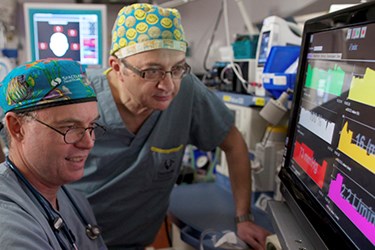This Sensor Enables Oximetry In A Smartphone
By Joel Lindsey

Researchers at the University of British Columbia have created a small, affordable, and accurate sensor that plugs into smartphones and other mobile electronic devices, enabling those devices to measure blood oxygen levels.
The device, researchers claim, could effectively turn a smartphone into a pulse oximeter.
“I honestly believe the day will come when everybody will have a kit with a thermometer, a pulse oximeter and a blood pressure cuff at home,” Mark Ansermino, director of research for pediatric anesthesia at British Columbia Children’s Hospital, associate professor in UBC’s department of anesthesia, and researcher involved with the project, said in a news article published recently by The Vancouver Sun. “My philosophy is that everybody needs to have one of these at home, but the potential is so much more. We are building predictive health care.”
The device, called the Phone Oximeter, uses a light sensor that attaches to the user’s fingertip in order to measure blood oxygen levels. Data is then delivered to a smartphone, tablet, laptop, or other personal electronic device, where the specially designed Phone Oximeter software analyzes and displays information in easy-to-read numbers and figures.
The Phone Oximeter plugs into the electronic device through a standard audio port, making it compatible with almost any mobile device, according to the Sun article. The device can also measure heart and respiration rates, and it can be used in conjunction with other monitoring equipment, such as blood pressure cuffs.
Because it has been designed primarily to measure blood oxygen levels, researchers claim that the Phone Oximeter and its accompanying software could be most effective for detecting early signs of pre-eclampsia in pregnant women and diagnosing pneumonia in young children.
In particular, researchers involved in the project see the Phone Oximeter as providing an effective means of monitoring health for those living in rural and economically underprivileged locations.
“I really want to make products that people — even in the most remote areas of the world — people will be able to afford to buy,” said Ansermino. “It’s really about the democratization of health care: how can we allow everybody to have the same level of health care and have technology enable that.”
Ansermino and the rest of the research team predict that the Phone Oximeter should be available for somewhere around $40, a notable difference from traditional pulse oximeters, which can cost more than $1,000 and are typically found only in hospitals and doctor’s offices.
Researchers and developers around the world continue working to devise new ways of turning smartphones and other types of mobile electronic devices into effective medical devices. Med Device Online recently published an article about efforts by scientists in Illinois to use smartphones as a way of measuring a patient’s gait, dubbed by some healthcare practitioners as the “sixth vital sign.”
Image Credit: UBC
